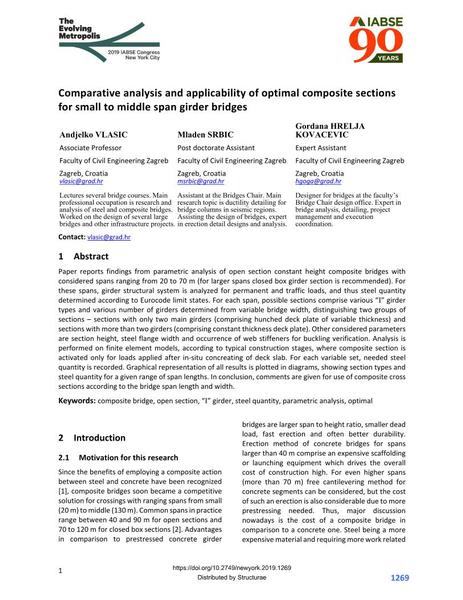Comparative analysis and applicability of optimal composite sections for small to middle span girder bridges

|
|
|||||||||||
Détails bibliographiques
| Auteur(s): |
Andjelko Vlasic
(Faculty of Civil Engineering Zagreb)
Mladen Srbić (Faculty of Civil Engineering Zagreb) Gordana Hrelja Kovačević (Faculty of Civil Engineering Zagreb) |
||||
|---|---|---|---|---|---|
| Médium: | papier de conférence | ||||
| Langue(s): | anglais | ||||
| Conférence: | IABSE Congress: The Evolving Metropolis, New York, NY, USA, 4-6 September 2019 | ||||
| Publié dans: | The Evolving Metropolis | ||||
|
|||||
| Page(s): | 1269-1273 | ||||
| Nombre total de pages (du PDF): | 5 | ||||
| DOI: | 10.2749/newyork.2019.1269 | ||||
| Abstrait: |
Paper reports findings from parametric analysis of open section constant height composite bridges with considered spans ranging from 20 to 70 m (for larger spans closed box girder section is recommended). For these spans, girder structural system is analyzed for permanent and traffic loads, and thus steel quantity determined according to Eurocode limit states. For each span, possible sections comprise various “I” girder types and various number of girders determined from variable bridge width, distinguishing two groups of sections – sections with only two main girders (comprising hunched deck plate of variable thickness) and sections with more than two girders (comprising constant thickness deck plate). Other considered parameters are section height, steel flange width and occurrence of web stiffeners for buckling verification. Analysis is performed on finite element models, according to typical construction stages, where composite section is activated only for loads applied after in‐situ concreating of deck slab. For each variable set, needed steel quantity is recorded. Graphical representation of all results is plotted in diagrams, showing section types and steel quantity for a given range of span lengths. In conclusion, comments are given for use of composite cross sections according to the bridge span length and width. |
||||
| Mots-clé: |
pont mixte
|
||||
